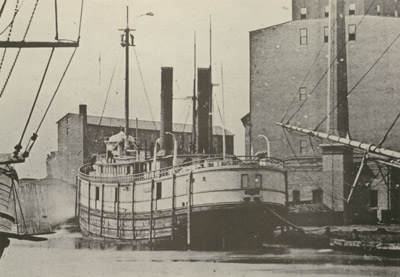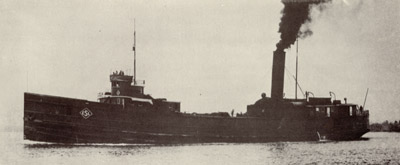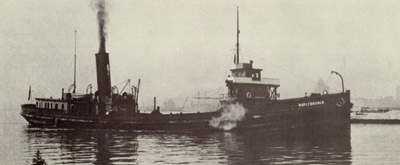Table of Contents
| Title Page | |
| Meetings | |
| The Editor's Notebook | |
| Marine News | |
| Books | |
| Vessel Passages | |
| Ship of the Month No. 22 Maplebranch | |
| Str. Majestic | |
| Table of Illustrations |
In this day of large modern lake vessels, we sometimes forget the important role played by the smaller freighters in the early development of the commerce of the Great lakes. We remember the beautiful steel steamers of Capt. John Mitchell and the Gilchrist Transportation Co. which not only revolutionized the development of the modern carrier and led ultimately to the giants of today, but which combined utility and gracefulness. However, we fail often to take the next step back into the past, to remember the little wood and iron-hulled combination passenger and package freight steamers of the second half of the nineteenth century. These steamers may have been crude in machinery, accommodations and cargo handling equipment, but they were, in their way, just as great a step forward as were their successors. Our ship for this month was one of these gallant little workhorses and proved her mettle by operating for the astonishingly long period of seventy-four years.
One of the early package freight lines on the upper lakes was the Commercial Line. This firm was founded in 1867 and was operated by Holt and Ensign of Buffalo. It was an "independent line," that is, it was not owned or managed by any of the railroads that operated extensive package freight services from Lake Erie to the upper lakes.

This very early photo, dating from about 1875, shows CUBA in the river at Chicago. Note the workment on the foremast. Bascom collection.
In 1872, the company had several new vessels built. One of them was an iron-hulled, twin-screw steamer constructed at Buffalo by the King Iron Works. Gibson and Craig were the sub-contractors. The new vessel was 231'7 in length, 35'7 in the beam, and 13'3 in depth. Her tonnage was 1526 Gross, 1359 Net. Given official number U.S. 125028, the steamer was christened CUBA. Her twin screws were driven by two steeple compound engines with cylinders 17" x 40" and a 36" stroke. The machinery was built by H. G. Trout and Company, Buffalo. No details are available on the original boilers.
CUBA was built of iron only up to the main deck. Above that point, she was wooden. In appearance she resembled so many other vessels of her type. She carried twin funnels athwartships and had the traditional octagonal "bird-cage" pilothouse on the hurricane deck. It was surmounted by the usual carved eagle. She was given a tremendous fidded foremast on which she originally carried sail. Passengers were carried in cabins on the upper deck,
CUBA operated on the Commercial Line's services from Buffalo to Duluth, Milwaukee, and Chicago. These routes continued until 1884 when the Commercial Line ceased operations. At this time, CUBA was sold to John Donaldson of Buffalo, She operated hence under the name of the Red Star Line, apparently managed by Drake and Maytham, the famous Buffalo steamship operators. They ran her for over two decades in conjunction with the Delaware, Lackawanna and Western Railroad. In 1888, she was given new fire-box boilers measuring 8'6 x 15'0.
Donaldson, or the Lackawanna Railroad, as the case may be, sold CUBA during 1906 to the Northern Navigation Co. which at that time needed another vessel for the Sarnia-Lakehead package freight trade. Simultaneously, the Canadian company acquired the steel package freighter TADOUSSAC from the Playfair interests. The two vessels were renamed IONIC and DORIC respectively in keeping with Northern Navigation's practice of giving all its ships names ending in the letters "IC", IONIC was enrolled as Can. 116954, registered at Sarnia, and was stripped of her cabins on the upper deck, She received a new boilerhouse, texas, and pilothouse. Her dimensions at this stage in her life were shown as 238'2 x 35'6 x 12'6, and her tonnage was 1708 Gross, 1030 Net.

IONIC is sseen at Sault Ste. Marie in this photo by A. E. Young. By this time she had but one funnel.
IONIC operated the upper lake route through several changes in ownership. In 1912, Northern Navigation was absorbed into the Richelieu and Ontario Navigation Co. Ltd., Montreal, and in December 1913 this firm in turn was amalgamated into the newly-formed Canada Steamship Lines Ltd., Montreal. Nevertheless, Northern Navigation was retained as an operating but wholly-owned subsidiary of C.S.L. During World War I, IONIC was transferred to the Toronto-Montreal run. However, she met misfortune on this route when she sank in the Williamsburg Canal in the St. Lawrence River on November 8, 1919. Soon salvaged, she was rebuilt and her twin funnels were replaced by a large and imposing single stack. She re-entered service in 1920 as (c) MAPLEBRANCH, a name that was to have considerable importance. At the time of her rechristening, C.S.L. was maintaining a rather interesting series of names. Vessels were being given names beginning with the prefix "MAPLE" indicative of their Canadian ownership. The suffixes began with the letter "H" to indicate steel-hulled canallers, as in MAPLEHURST, MAPLEHILL and MAPLEHEATH, with the letter "G" to indicate wooden canallers like MAPLEGREEN, MAPLEGLEN and MAPLEGULF, and with "B" to indicate iron canallers such as MAPLEBORO, MAPLEBROOK and MAPLEBRANCH herself.
When she re-entered service after her accident, MAPLEBRANCH was placed on the package freight service between Montreal and the Canadian Lakehead. She continued thus until 1926 when she was rendered surplus and was laid up. She and her aging running mates were replaced by the new City Class of fast steel package freighters. She was sold in 1928 to St. Lawrence Tankers Ltd., an outgrowth of the Webster group of companies which included the Canada Import Co. She was converted at Montreal to a tanker for use on the St. Lawrence River and her tonnage was altered to 1014 Gross, 634 Net. Her dimensions were now shown as 231'8 x 35'5 x 12'6. In this conversion she was cut down to the main deck and was given a new triple deck, but rather ancient looking, pilothouse set back from the bow.
MAPLEBRANCH operated in the petroleum products trade until August 13, 1934. The thirteenth was unlucky for the steamer even if it did fall on a Monday that month, for MAPLEBRANCH was rammed and sunk in Montreal harbour by the British "D" Class cruiser H.M.S. DRAGON. The diminutive tanker was subsequently raised and taken to Sorel, Quebec, by Marine Industries Ltd. who rebuilt her in 1935 in their yard on the Richelieu River. Re-registered in Sorel, she maintained her previous appearance but was given new boilers. These were two second-hand Scotch boilers measuring 11'2 x 11'2 and built in 1891. It is not known what ship they had served in previously.
To operate MAPLEBRANCH, Marine Industries formed a new subsidiary, namely Branch Lines Ltd., many of whose later vessels would bear the suffix "BRANCH" in their names, taken from this historic ship, and a prefix taken from the name of some other tree found in Canada, such as "POPLAR," "PINE," "SPRUCE," etc. The same firm is currently operating a modern diesel tanker carrying the name MAPLEBRANCH (II).

The final rebuild left MAPLEBRANCH looking like this. She is sesen entering the Toronto Ship Channel in this 1939 photo by J. H. Bascom.
For the last eleven years of her operating life, MAPLEBRANCH plodded around the lower lakes and the St. Lawrence River. Indeed for the last few years her certificate was restricted to allow her to operate only below Port Colborne. This regulation was allegedly brought on by an unfortunate attempt to buck the spring ice in Lake Erie one year. Despite her apparent lack of power, her antiquated appearance, and the natural loosening-up that comes with age, MAPLEBRANCH continued on through her seventy-fifth season and was finally retired during 1946. She was laid to rest in the company's boneyard at Sorel and was stripped of her upperworks. Accompanied by several other interesting old vessels, the hull, complete with its wooden bulwarks and with the name still showing proudly on the bow, lay in peace into the early 1950's when it was finally dismantled. She was still in documentation as late as 1950.
At the time of her scrapping, MAPLEBRANCH was the oldest iron-hulled ex-package freighter still in existence on the lakes. Out of all the similar vessels which had been built in the 1870's and 1880's, she was survived only by PONOKA (ex LEHIGH) and ALGONAC (ex SYRACUSE) which lasted a few years longer, but these steamers were a decade younger, not being built until 1880 and 1884 respectively. Yes, CUBA - IONIC - MAPLEBRANCH proved her worth over the years and her builders would have been proud had they but known how long she would serve.
Previous Next
Return to Home Port or Toronto Marine Historical Society's Scanner
Reproduced for the Web with the permission of the Toronto Marine Historical Society.